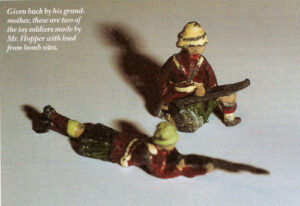
How I well remember the day just after the Second World War, before the luxury of central heating and when coal fires were the norm, when I took my first step into the commercial world.
I was 14 years old at the time and intrigued by a jolly old be-grimed cockney chimney sweep who came to our house every so often to clean out the chimney. He’d screw his flue brushes together and, after laying old sheets around our fireplace, would push the brush, connected to rod after rod, up the chimney. The soot would come flowing down and all the time he’d be chatting away merrily.
He told me that his son made lead soldiers, casting them in moulds then painting them. If I liked, he said, I could have a look at his son’s mould catalogue. This set me thinking, and it was not long before I was swinging into action.
In those days there were plenty of bomb sites in the South Coast town where I lived, and consequently plenty of old lead piping lying aroundjust waiting to be cleared up.
I saved up my half a crown a week pocket money until I had enough to buy two moulds from the catalogue, and eagerly awaited the postman bringing my package. Imagine my excitement as I opened the parcel and there were my two kilted Scottie soldier moulds, one prone firing and the other kneeling. I soon had the production line in motion.
With the lead already collected, I bought a second-hand ladle into which I put pieces of old lead, then placed the ladle on our open coal fire. It didn’t take long for the lead to melt, then the molten silver liquid was poured into the clamped moulds leaving behind the dross in the bottom of the ladle. The moulds were left to cool, then after a sharp tap with a hammer the mould would fall apart.
There, in all its shining glory, was my Scot-
tie soldier. The rim around the edge of the figure, where the mould had been clamped together, was pared smooth with a penknife and my Scottie was ready for painting.
White pith helmet, pink face, red coat with white cross straps, green kilt, red-topped white socks and black boots and it seemed to me that my Scottie had almost come alive.
After I’d made a dozen, six kneeling and six prone, I sewed them into a cardboard box and my first commercial venture was ready for launching.
As I was a newspaper boy at the time, my first port of call was the newsagent for whom I worked. “OK,” he said, “I’ll put them in my window. I’ll sell a dozen for five bob, and give you half a crown with each box sold”.
“Done!” I said.
A budding stamp collector at time, I bought King George VI British Common-
wealth stamps with the profits and some of them, I’m pleased to say, are worth quite a bit today.
Several years ago, just before my grandmother passed on, she sent me two of these Scottie soldiers which I’d presented to her in the days of myyouth. I hadn’t kept any for myself, and to be honest I’d had forgotten all about them as, of course, lead soldiers went out of fashion with the introduction of plastic many moons ago.
Now I treasure these soldiers, for they are a reminder of the days before computer games and other such wizardry when we made our own amusements and enjoyed a perhaps more simple life. Days when a chat with a chimney sweep could provide a most enjoyable and rewarding hobby and launch a post-wartime youngster into a brave new commercial world.
Brian Hopper








